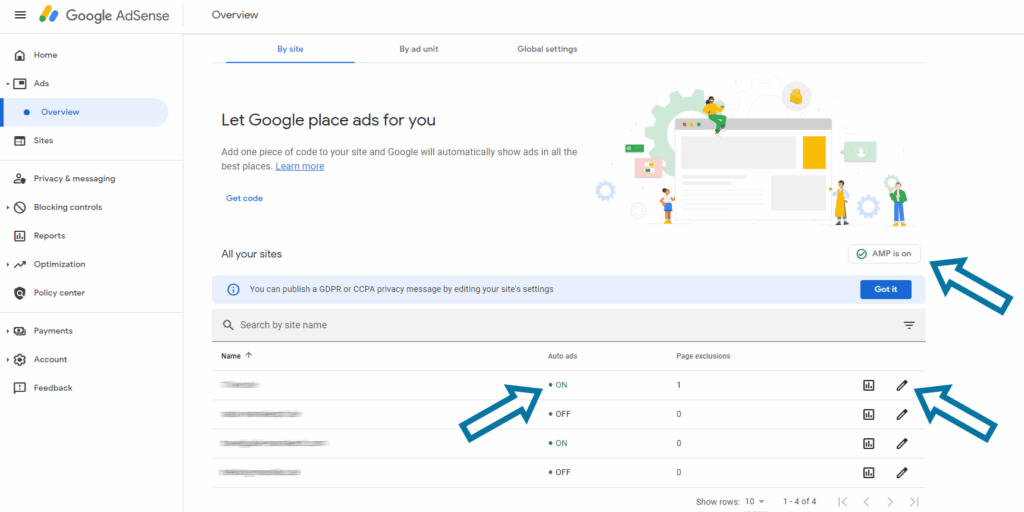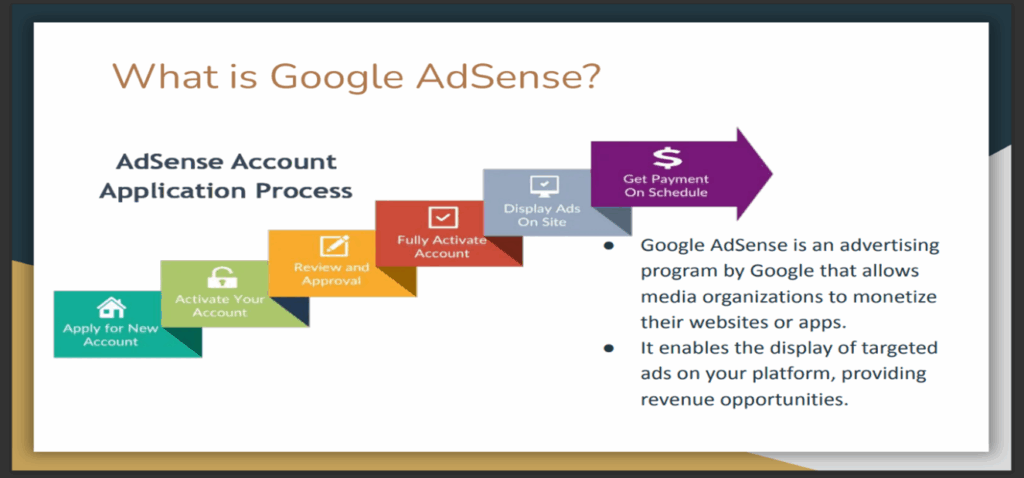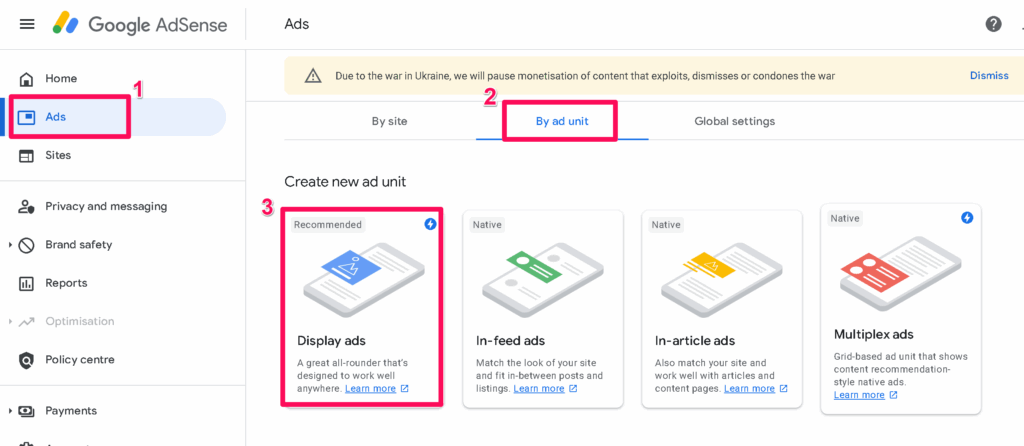How to post ad on Google AdSense

Google AdSense is one of the simplest and most popular solutions for website owners with steady traffic who want to start earning money. With its automated ad-matching system, Google AdSense allows you to generate passive income without having to directly sell products or market services. In this article, RentAds will guide you through the detailed how to post ad on google adsense so you can fully unlock your website’s earning potential.
How does Google AdSense work?

To start earning money with Google AdSense or to understand how ads are displayed on websites, you need to grasp the fundamentals of the platform and how it functions within the Google ecosystem. Below are the key concepts that will help you better understand the system before getting started.
Overview of Google AdSense
Google AdSense is a display advertising platform provided by Google that allows website, blog, forum, or other content platform owners to show third-party ads on their pages and earn revenue from clicks or impressions. When you join AdSense, Google automatically displays ads on your site based on its content and user behavior. You don’t need to manually look for advertisers—Google handles ad placement, payment processing, reporting, and optimization. This is one of the most popular forms of passive income for content publishers.
The difference between AdSense and Google Ads
Although both belong to Google’s advertising ecosystem, Google AdSense and Google Ads serve two entirely different user groups. Google Ads is a platform for those who want to run ads to attract customers, sell products, or promote services. These users pay to have their ads displayed on Google Search, YouTube, or other websites. On the other hand, Google AdSense is for those who want to earn money by allowing Google to display ads on their own websites. Instead of paying, they earn revenue based on ad clicks (CPC) or impressions (CPM) generated from the ads shown on their site.
AdSense ad delivery mechanism
Google AdSense operates based on a real-time bidding mechanism. When a user visits your website, the system instantly scans the page content, user behavior, and other contextual information to select the most relevant ad. At that moment, advertisers in Google Ads compete in an automated auction to display their ads on your site.
The ad with the highest and most relevant bid will be displayed. You’ll earn a share of the amount the advertiser pays to Google, typically based on a CPC (cost-per-click) or CPM (cost per mille – per 1,000 impressions) model. The strength of this mechanism lies in its flexibility, automated optimization, and efficiency. You don’t need to manually manage ads, yet you can still receive high-quality ads that align with your audience and content.
Eligibility criteria for Google AdSense advertising
Make sure your website meets Google’s basic requirements. These criteria not only help you get approved faster but also ensure long-term account stability. Below are three key categories of requirements you need to understand clearly.
Website content requirements
Google prioritizes websites with original, helpful, easy-to-read content that is relevant to users. Your site should have at least 15–30 high-quality articles that are regularly updated, not copied from other sources, and provide real value to readers. Make sure your website includes an About page, a Privacy Policy, and a Contact page—these are signs that you are a trustworthy publisher. A user-friendly, easy-to-navigate interface is also a major plus when Google reviews your AdSense application.
Traffic requirements and policy compliance
Although Google does not officially disclose a minimum traffic requirement, websites with steady traffic from legitimate sources—such as Google Search, social media, or direct visits—tend to have a higher approval rate. Avoid using artificial traffic-boosting techniques, as Google has strict fraud detection tools. Your website must fully comply with Google’s policies, including the Content Policy, User Behavior Policy, and Website Quality Guidelines.
Content types banned by Google AdSense
Google AdSense has a clear list of content types that are not allowed to display ads, in order to maintain a healthy advertising ecosystem. Some strictly prohibited content includes:
- Pornographic, violent, or shocking content
- Misinformation, fake news, and hateful content
- Content that promotes dangerous or illegal behavior
- Content involving gambling, tobacco, stimulants, or weapons is not permitted.
Websites with auto-generated content or those containing malware, abnormal redirects, or similar issues will be immediately rejected by Google. Ensuring clean, transparent, and valuable content for users is a prerequisite for long-term participation in AdSense.
Detailed instructions on how to post ad on google adsense

Publishing ads through Google AdSense isn’t overly complicated, but to implement it successfully and get approved quickly, you need to follow the correct step-by-step process.
Step 1: Create A Google AdSense Account
First, you need to visit the Google AdSense website and start the account registration process. Here, you’ll enter basic information such as your website URL, email address, and country of residence. Google requires that your website has clear content, complies with its policies, and maintains stable traffic. Once registration is complete, you’ll be taken to the management dashboard to proceed with the next steps.
Step 2: Add the ad code to your website
After registering an account, Google will provide you with an ad code (AdSense code). To display ads, you need to insert this code into the “Head” section of your website. If you’re using a platform like WordPress, you can use a plugin such as “Insert Headers and Footers” to add the code easily. Properly placing the code allows Google to scan your website’s content and begin serving relevant ads.
Step 3: Configure ad placements and types
Once your account is linked to your website, you can configure ad placements such as at the top of the page, within the content, in the sidebar, or in the footer. Additionally, you can choose the type of ads to display: text ads, display (banner) ads, in-article ads (within the content), or contextually relevant link ads. Choosing the right ad format and placement has a significant impact on your click-through rate (CTR) and AdSense revenue.
Step 4: Submit for review and wait for approval
After completing the setup, you need to submit your website for Google’s review. During the review process (which usually takes a few hours to a few days), Google will evaluate your site’s content, layout, loading speed, and policy compliance. To increase your chances of approval, make sure your website has at least 10–15 quality articles, a clear and user-friendly interface, and contains no prohibited content such as plagiarism, adult material, violence, or promotion of illegal goods.
Step 5: Performance tracking and optimization
Once ads start displaying, you should regularly access your Google AdSense dashboard to monitor key metrics such as revenue, click-through rate (CTR), impressions, and the types of ads performing well. Based on this data, you can adjust ad placement, ad types, or your website layout to improve effectiveness. Additionally, make sure to comply with Google’s policies to avoid account suspensions or warnings.
Contact Info
Are you in need of Facebook advertising or need to rent a quality Facebook advertising account? Don’t worry! Rentads is a unit specializing in providing reputable Facebook accounts, as well as direct advertising support. Provides all types of advertising accounts such as google ads account for rent to help you reach and create fast conversions.
Frequently Asked Questions
You only need one Google AdSense account to display ads across multiple websites. However, each new website must be reviewed and approved before ads can appear. Google will assess the quality and eligibility of each additional site.
Google AdSense permits displaying ads from other networks like Media.net, PropellerAds, and others, provided that ad spaces are kept separate, ad codes are not mixed, and the user experience is not compromised.